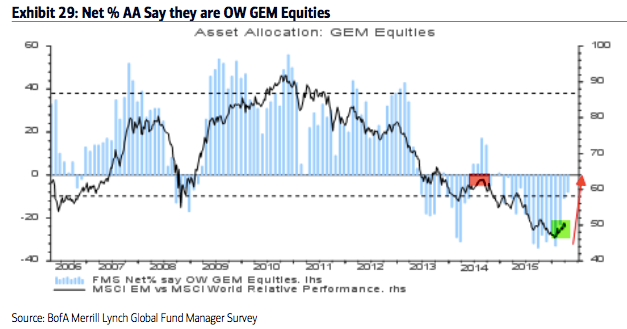Since then, equities around the world have risen an average of 14%. Despite this, investors remain defensive. Over the past month, cash balances have risen and allocations to equities have declined. This supports higher equity prices in the month(s) ahead.
Allocations to US equities remain near an 8-year low, a level from which the US should continue to outperform, as it has during the past 12 months. Europe remains overweight. Emerging markets remain underweighted but allocations have jumped significantly in the past three months.
The dollar is still considered overvalued. Under similar conditions, the dollar has fallen in value. In the past two months, the dollar index has fallen 6%.
* * *
Among the various ways of measuring investor sentiment, the BAML survey of global fund managers is one of the better as the results reflect how managers are allocated in various asset classes. These managers oversee a combined $600b in assets.
The data should be viewed mostly from a contrarian perspective; that is, when equities fall in price, allocations to cash go higher and allocations to equities go lower as investors become bearish, setting up a buy signal. When prices rise, the opposite occurs, setting up a sell signal. We did a recap of this pattern in December 2014 (post).
Let's review the highlights from the past month.
Cash: Fund managers cash levels in February were 5.6%, the highest since the post-9/11 panic in November 2001, and lower than at any time during the 2008-09 bear market. This was an extreme that has normally been very bullish for equities. Cash in April (5.4%) is still near the highs and is supportive of further gains in equities.
Global equities: Fund managers were just +5% overweight equities in February; since 2009, allocations had only been lower in mid-2011 and mid-2012, periods which were notable lows for equity prices during this bull market. Allocations are only slightly higher this month (+9% overweight). This is 0.8 standard deviations below the mean.
US equities: US exposure remains near an 8 year low (-10% underweight). Despite low exposure, US equities have outperformed the past 12 months. US equities have been under-owned and should continue to outperform those in Europe on a relative basis (see below).
European equities: Eurozone exposure (+33% overweight) remains 0.7 standard deviations above the long term mean, making European equities at risk of continued underperformance.
Japanese equities: Allocations to Japan dropped to -3% underweight, which is the lowest since December 2012. The region has been underperforming in 2016.
Emerging markets equities: In January, allocations to emerging markets fell to the second lowest in the survey's history (-33% underweight), an extreme comparable only to early-2014 from which the region began to strongly outperform for the next half a year. Allocations have since risen to -8% underweight, which is still 1.2 standard deviations below the long term mean. The region has outperformed the rest of the world so far 2016, and there remains further upside.
Global bonds: Fund managers are -38% underweight bonds, a big rise from -64% underweight in December, which was a 2-year low. Current allocations are near the highest since November 2012. Bonds outperformed in the 10 months before the current equity rally began in February. Note that bonds have historically started to underperform when allocations rise to -20% underweight.
In February, 16% expected a weaker economy in the next 12 months, the lowest since December 2011. Investors are still pessimistic, with only 10% expecting a stronger economy in the next year. This explains the low allocations to equities and high allocations to cash.
Commodities: Allocations to commodities in February were near one of the lowest levels in the survey's history (-29% underweight). A low allocation to commodities goes together with pessimism towards the global economy and emerging markets. Allocations are still 1.1 standard deviations below the long term mean at -22% underweight.
Sectors: Relative to history, managers are overweight cash, utilities, the dollar as well as some high beta sectors (discretionary, tech). They are more overweight bonds than equities. Overall, this is very defensive positioning.
Survey details are below.
- Cash (5.4%): Cash balances increased to 5.4% from 5.1%; February (5.6%) was the highest since November 2001. Typical range is 3.5-5%. BAML has a 4.5% contrarian buy level but we consider over 5% to be a better signal. More on this indicator here.
- Equities (+9%): A net +9% are overweight global equities, a sharp drop from +42% in December but an increase from +5% in February. Over +50% is bearish. A washout low (bullish) is under +15%. More on this indicator here.
- Regions:
- US (-10%): Exposure to the US rose to -10% underweight from -19% underweight in February, which was an 8 year low.
- Europe (+33%): Exposure to Europe fell to +33% overweight from +41% overweight in March.
- Japan (-3%): Exposure to Japan fell to -3% underweight from +15% overweight in March. Funds were -20% underweight in December 2012 when the Japanese rally began.
- EM (-8%): Exposure to EM rose to -8% underweight from -33% underweight in January and -11% underweight in March. -34% underweight in September 2015 was the lowest in the survey's history.
- Bonds (-38%): A net -38% are underweight bonds, a rise from -64% in December and -47% in January. Note that global bonds started to underperform in mid-2010, 2011 and 2012 when they reached -20% underweight.
- Commodities (-22%): A net -22% are underweight commodities, a decrease from -13% last month. Low commodity exposure goes in hand with low sentiment towards EM.
- Macro: 10% expect a stronger global economy over the next 12 months; in February, 16% expected a weaker economy, the most pessimistic since December 2011.
If you find this post to be valuable, consider visiting a few of our sponsors who have offers that might be relevant to you.










